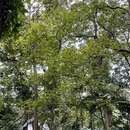Comprehensive Description
provided by North American Flora
Bauhinia ligulata Pittier, Contr. U. S. Nat. Herb. 20: 112. 1918
A large tree, 40 m. high, with a trunk 8 dm. in diameter, the twigs glabrate, unarmed. Stipules minute, caducous; petioles 2 cm. long; blade broadly ovate, 4-10 cm. long, cordate at base, notched at apex, glabrous and somewhat shining above, pale and puberulent beneath, 11-13-nerved; inflorescence racemose, often somewhat paniculate; buds 1.5-2.5 cm. long; calyx-lobes 5, narrow, 14 mm. long, distinct after flowering; petals 5, ovate-elliptic, acute, 3 cm. long, with a short claw, lilac, veined with purple; stamens 10, all fertile, glabrous; ovary glabrous, stipitate.
Type locality: Puerto Obaldia. San Bias Coast, Panama. Distribution: Known only from the type locality.
- bibliographic citation
- Nathaniel Lord Britton and Joseph Nelson Rose. 1928. (ROSALES); MIMOSACEAE. North American flora. vol 23(1). New York Botanical Garden, New York, NY
Bauhinia picta: Brief Summary
provided by wikipedia EN
Bauhinia picta, known as the algodoncillo, casco de vaca, palo de orquídeas, or pata de vaca, is a species of plant in the family Fabaceae. It is found in Colombia, México,Panama, and Venezuela.
- license
- cc-by-sa-3.0
- copyright
- Wikipedia authors and editors

